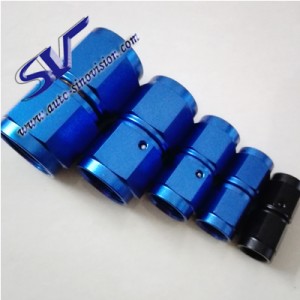A production method in which liquid metal is poured into a mold cavity suitable for the shape and size of a part, and then cooled and solidified to obtain a blank or a part is usually called liquid metal forming or casting. For example, our products: brake female inverted flare hose, an6 / an8 an10 female to male pair wire oil circuit modification connector, An3 / an4 / an6 / an8 / an10 female flare swing modified double side female aluminum pair wire.
Process flow: liquid metal → mold filling → solidification shrinkage → casting
Process characteristics:
1. It can produce products with arbitrary complex shapes, especially those with complex internal cavity shapes.
2. Strong adaptability, unlimited alloy types and almost unlimited casting sizes.
3. Wide source of materials, remelting of waste products and low equipment investment.
4. High scrap rate, low surface quality and poor labor conditions.

Casting classification:
(1) Sand casting
A casting method for producing castings in sand molds. Steel, iron and most non-ferrous alloy castings can be obtained by sand casting.
Technical features:
1. It is suitable for making blanks with complex shapes, especially with complex internal cavities;
2. Wide adaptability and low cost;
3. For some materials with poor plasticity, such as cast iron, sand casting is the only forming process for manufacturing its parts or blanks.
Application: automotive engine cylinder block, cylinder head, crankshaft and other castings
(2) Investment casting
Generally, it refers to a casting scheme in which a pattern is made of fusible materials, several layers of refractory materials are coated on the surface of the pattern to make a mold shell, and then the pattern is melted out of the mold shell, so as to obtain a mold without parting surface, which can be filled with sand and poured after high-temperature roasting. It is often called “lost wax casting”.
advantage:
1. High dimensional accuracy and geometric accuracy;
2. High surface roughness;
3. It is possible to cast a casting with a complex shape and the cast alloy is not limited.
Disadvantages: complicated process and high cost
Application: it is applicable to the production of small parts with complex shapes, high accuracy requirements, or difficult to be processed in other ways, such as turbine engine blades.
(3) Die casting
High pressure is used to press molten metal into a precision metal mold cavity at high speed, and the molten metal is cooled and solidified under pressure to form a casting.
advantage:
1. High pressure and fast flow rate of metal liquid during die casting
2. Good product quality, stable size and good interchangeability;
3. High production efficiency, more use times of die-casting die;
4. It is suitable for mass production and has good economic benefits.
Disadvantages:
1. The castings are easy to produce fine pores and shrinkage porosity.
2. The die casting has low plasticity and is not suitable for working under impact load and vibration;
3. When high melting point alloy is used for die casting, the mold life is low, which affects the expansion of die casting production.
Application: die casting was first applied in automobile industry and instrument industry, and then gradually expanded to various industries, such as agricultural machinery, machine tool industry, electronic industry, national defense industry, computer, medical equipment, watches, cameras, daily hardware and other industries.
Post time: Sep-06-2022

